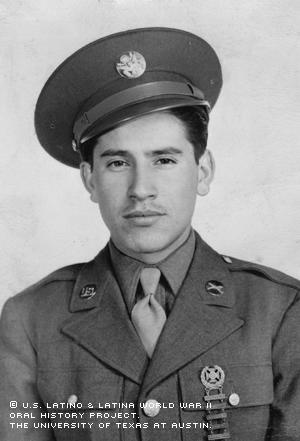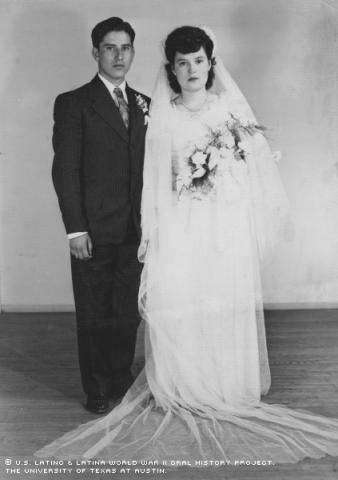

By Heather Cuthbertson
In 1944, Herman Saiz wasn’t sure what he wanted to do with his life. He’d always tried to help his family, but without a father and clear path to follow, he enlisted to fight in the South Pacific during World War II.
Like many young men at the time, Saiz viewed the war effort as a duty and responsibility. It was something he had to do. The uncertainty with which he’d lived was gone. The only thing that mattered was to help win the war -- and survive.
Saiz was born August 10, 1924, in Anton Chico, N.M. He was one of 15 children born to his parents, Tranquilleno Saiz and Tiodorita Bachicha Saiz.
At age 7, Saiz's father died, the victim of a railroad accident while working for Southern Pacific Railroad in Santa Rosa, N.M.
Death was common for the Saiz family. Saiz says that out of the 15 children, only he and his sister, Nera, survived to be adults. His recollection of his siblings is faint.
After Tranquilleno died, the family moved to Santa Rosa. There, Saiz attended public school at West Las Vegas. He spent most of his time either working for his uncles on the farm back in Anton Chico or helping his mother.
Saiz never graduated from high school, as he completed only half of his freshman year. His mother needed financial help, so Saiz moved to Rockyford, Colo., where he spent his days on farms picking produce. But after a year and a half, Saiz says he’d had enough.
He returned to Las Vegas in 1944 to see his family and friends. Many of his friends had enlisted in the military and he believed the Army was also for him.
Saiz enlisted and was sent to Camp Robinson in Little Rock, Ark., for basic training. After about three months of training, he was told to report to Fort Ord in California and subsequently sent to the South Pacific.
Saiz was assigned as a replacement to Company G of the 2nd Battalion, 34th Infantry Regiment, 24th Infantry Division. He says his regiment was transported to the South Pacific, but the troops were unaware of what the destination point was until they were almost to the Philippines.
"The boat was horrible," he said. "The food wasn't that good, and most of the time you got any food, the seasickness hit."
The infantry had been told they were going to land on Leyte Island in the Visayan Islands of the Philippines. Saiz was made a first scout.
The fighting started quickly; the infantry received fire the second day they landed. Saiz describes his regiment as a clean-up crew for the Marines.
"The Marines were there before us," he said. "We went in to mop up their mess and finish off the Japanese."
As a first scout, Saiz led the way for his battalion, and was in charge of letting the others know if there was trouble up ahead.
A month after landing on Leyte, he recalls he and a second scout were on patrol when they encountered enemy fire. The second scout was killed.
Saiz recalls he was coming over a hill when he saw Japanese soldiers with guns drawn. He says he immediately fell to the ground. The second scout, however, came over the top and "they just let him have it," Saenz said.
"I sat there and talked to him for three to four minutes. … He just asked me to do him a favor: 'Write a letter to my Mom and Dad. Don't tell them what happened; just tell them I am dead.'"
Saiz wrote the letter to the soldier's parents, who later sent him a thank-you card.
After a couple of months in Leyte, Saiz’s battalion was sent to Luzon to relieve another company. The fighting there was just as fierce as in Leyte.
The artillery fire was so intense it was like "the rain came down," said Saiz of the multitude of mortar shells that fell one particular day.
"We tried to get as low as possible and dig even lower with our shovels. … As the shells came down, the man on the left of me and the man on the right of me were hit and killed."
At the end of the day, only 50 of the 250 men in Saiz’s company escaped unharmed. The others had already died or would later die from their wounds. They’d stay on Luzon for three months, before being shipped to Mindanao.
Saiz's good fortune finally ran out on Mindanao. He was hit by shrapnel on two different occasions, the second forcing him to a war hospital, where he finished out the last days of the war.
The Japanese surrendered while he was recovering from his wounds at the hospital. He was later released from the hospital and shipped to Hiroshima, where he rejoined his regiment.
Saiz arrived in Hiroshima in October of 1945; two months after the atomic bomb had been dropped.
"We had no special suits [for the radiation]," he said of the devastation. "We just looked at nothing, there was nothing left."
Saiz's company was the last to leave Hiroshima in 1945, when they were shipped to Seattle, Wash. Saiz, who attained the rank of Private First Class, was honorably discharged May 17, 1946. He received the Purple Heart Medal, a CIB, Bronze Star, Victory Medal, Philippine Liberation Medal, American Theater Ribbin and Good Conduct Medal.
With nowhere else to go, he returned home.
The New Mexico native spent the next 40 years bouncing around from job to job. His longest stint was 13 years with a wholesale company in Las Vegas.
Saiz married Lucy Fresquez on July 8, 1946, and the couple had three children. Their first child, Herman Saiz, Jr., died at six months. Their other children, John and Patsy, have provided them with five grandchildren. All of the family still lives in and around Las Vegas, N.M., says Saiz, to whom it’s important to be close to family.
His son and grandson have followed his footsteps in joining the military. He says the effects of WWII caught up with him in the late 1980s, when he was diagnosed as having prostate cancer. After a couple of years of taking medication, he had his prostate removed in 1991.
Saiz says he didn’t like the idea of chemotherapy and being exposed to radiation, so he chose to have the surgery. He blames the radiation exposure in Hiroshima on his cancer, and currently receives Department of Veterans Affairs relief.
Although Saiz didn’t have any footsteps to follow when he was growing up, he has clearly left strong footprints behind for younger generations to follow.
Mr. Saiz was interviewed in Santa Fe, New Mexico, on November 3, 2002, by M. David Gray.

